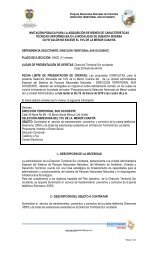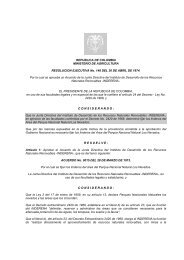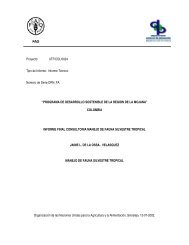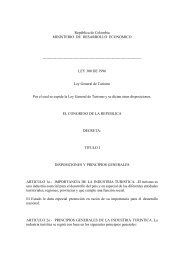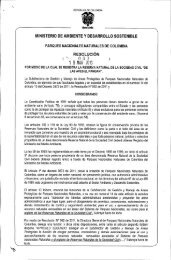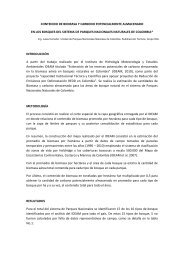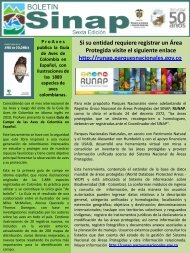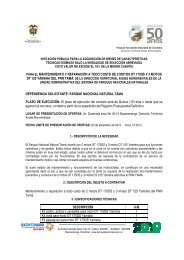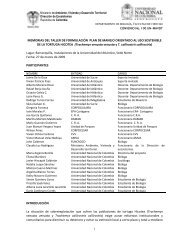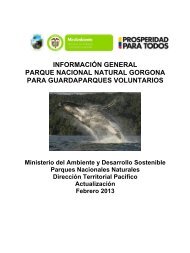Política de Administración de Riesgos - Parques Nacionales de ...
Política de Administración de Riesgos - Parques Nacionales de ...
Política de Administración de Riesgos - Parques Nacionales de ...
You also want an ePaper? Increase the reach of your titles
YUMPU automatically turns print PDFs into web optimized ePapers that Google loves.
Association for the Advancement of Computing In Education Journal, 16(2)methods for teaching in this kind of setting. Learners and instructors bothneed to adapt and change as they learn how to use this new medium.Additionally, instructors, instructional <strong>de</strong>signers, and other professionalsworking in the <strong>de</strong>sign of online environments for adults must un<strong>de</strong>rstandadult learning theory, especially in terms of its relationship to distance oronline learning. According to Moore and Kearsley (1996), "most distanceeducation stu<strong>de</strong>nts are adults between the ages of 25 and 50. Consequentlythe more one un<strong>de</strong>rstands the nature of adult learning, the better one canun<strong>de</strong>rstand the nature of distance learning" (p. 153).More distance learning programs are being <strong>de</strong>veloped annually; therefore,increasing numbers of adult learners will be tapping into this new resourcefor education. According to the U. S. National Center for EducationStatistics (2002), 56% of all 2- and 4-year <strong>de</strong>gree-granting institutions offerdistance education courses for all types of stu<strong>de</strong>nts. The Sloan Consortium'sfourth annual report (2006) on the state of online education in U.S. highereducation reported: (a) almost two-thirds of all schools offering face-to-facecourses also offer online courses, (b) the growth rate of online enrollmentbetween 2004 and 2005 was 35%. The year 2004-2005 <strong>de</strong>monstrated thelargest increase in the number of online stu<strong>de</strong>nts as well as the largestpercentage increase in online enrollment growth (Allen & Seaman, 2006).Adult learners are different from traditional college stu<strong>de</strong>nts. Many adultlearners have responsibilities (e.g., families and jobs) and situations (e.g.,transportation, childcare, domestic violence and the need to earn an income)that can interfere with the learning process. Most adults enter educationalprograms voluntarily and manage their classes around work and familyresponsibilities. Additionally, most adult learners are highly motivated andtask-oriented (Merriam & Caffarella, 1999).Adults have many challenges today, such as multiple careers, fewer stablesocial structures to rely on, living longer, and <strong>de</strong>aling with aging parents.The past is less helpful as a gui<strong>de</strong> for living in the present. Adults areinsecure in many <strong>de</strong>cisions that they need to make. Life is complex due tocareer, family, and other personal choices.Biological changes take place as individuals age, and it has been shown thatmemory <strong>de</strong>creases with age. It is memory that helps to form links betweennew and old information (Merriam & Caffarella, 1999). Short-term memoryor working memory is limited to approximately five to nine bits of new139
probabilidad pue<strong>de</strong> establecerse teniendo en cuenta información histórica o basarse en laexperiencia.Controles existentes. Los controles son aquellos mecanismos que intervienen los riesgoscon el fin <strong>de</strong> disminuir la probabilidad <strong>de</strong> que se materialice el riesgo. Ej. Reuniones,acuerdos, convenios, listas <strong>de</strong> chequeo, protocolos, entre otros.6.3 Manejo <strong>de</strong> los riesgosTeniendo en cuenta el análisis y valoración <strong>de</strong>l riesgo, las Depen<strong>de</strong>ncias <strong>de</strong> los nivelesCentral, Territorial y Local <strong>de</strong>ben ejecutar los tratamientos a<strong>de</strong>cuados, <strong>de</strong> acuerdo con lossiguientes lineamientos:En coherencia con el sistema <strong>de</strong> gestión <strong>de</strong> calidad <strong>de</strong> la Entidad, el tratamiento <strong>de</strong> losriesgos <strong>de</strong>be surtir los pasos establecidos en el procedimiento <strong>de</strong> acciones correctivas ypreventivas.Para <strong>Parques</strong> <strong>Nacionales</strong> Naturales evitar el riesgo <strong>de</strong>be ser la primera alternativa aconsi<strong>de</strong>rar, es <strong>de</strong>cir que se <strong>de</strong>ben buscar opciones <strong>de</strong> tratamiento encaminadas a prevenirque se materialice el riesgo. Se evita el riesgo cuando el plan <strong>de</strong> acción implica cambiossustanciales en los procesos que eliminen las causas i<strong>de</strong>ntificadas.Si el riesgo no pue<strong>de</strong> ser evitado se <strong>de</strong>be reducir, es <strong>de</strong>cir, se <strong>de</strong>ben toman medidastendientes a disminuir la probabilidad (prevención) y el impacto (protección). La probabilidad<strong>de</strong> ocurrencia se disminuye con la implementación <strong>de</strong> controles aplicables a las causas <strong>de</strong>lriesgo, mientras que el impacto se reduce estableciendo planes <strong>de</strong> contingencia. En loscasos en que la opción <strong>de</strong> manejo sea reducir el riesgo, el plan <strong>de</strong> acción <strong>de</strong>be contar conestos dos elementos.Una acción para las opciones <strong>de</strong> manejo <strong>de</strong> evitar o reducir el riesgo, pue<strong>de</strong> sercompartirlo o transferirlo. Estas acciones consisten en involucrar en el tratamiento <strong>de</strong>lriesgo a un tercero, ajeno a la Entidad. Ej. Asegurar bienes, firmar convenios y acuerdos,entre otros.<strong>Parques</strong> <strong>Nacionales</strong> asume el riesgo cuado la valoración <strong>de</strong>l mismo arroja que laprobabilidad <strong>de</strong> ocurrencia es baja, el impacto es leve y los controles existentes, se aplicany sirven para: combatir, minimizar o prevenir el riesgo (evitar o reducir el riesgo).Necesariamente el manejo <strong>de</strong> los riesgos <strong>de</strong> los niveles Local y Territorial <strong>de</strong>be ser sometidoa análisis por parte <strong>de</strong> los responsables <strong>de</strong> los procesos, quienes se <strong>de</strong>ben apoyar en lolí<strong>de</strong>res <strong>de</strong> los subprogramas <strong>de</strong>l plan estratégico, con el fin <strong>de</strong> generar un plan <strong>de</strong> accióninstitucional a<strong>de</strong>cuado a la magnitud <strong>de</strong> los riesgos <strong>de</strong>tectados.Copia No Controlada6.4 Monitoreo <strong>de</strong>l mapa <strong>de</strong> riesgosEl monitoreo <strong>de</strong> riesgos tiene como objetivo evaluar la efectividad <strong>de</strong>l plan <strong>de</strong> acción sobrela reducción <strong>de</strong> la probabilidad <strong>de</strong> ocurrencia <strong>de</strong>l riesgo o <strong>de</strong>l plan <strong>de</strong> contingencia para ladisminución <strong>de</strong> los impactos generados en caso <strong>de</strong> materializarse. Por otro lado, busca<strong>de</strong>tectar cambios en las causas <strong>de</strong> los riesgos, riesgos nuevos o eliminación <strong>de</strong> riesgos.Página 5 <strong>de</strong> 6
Para realizar el monitoreo, el mapa <strong>de</strong> riesgos <strong>de</strong>be contar con un plan <strong>de</strong> acción eindicadores que permitan hacerle seguimiento.El monitoreo estará a cargo <strong>de</strong> cada responsable <strong>de</strong> proceso, director territorial oadministrador <strong>de</strong> área, quienes <strong>de</strong>berán reportar semestralmente al Grupo <strong>de</strong> ControlInterno los controles que se han realizado sobre los riesgos i<strong>de</strong>ntificados y si algún riesgo seha materializado <strong>de</strong>be indicarse las causas reales que lo ocasionaron, el impacto quegeneró, activida<strong>de</strong>s que se realizaron para control sus efectos e impactos y los resultados<strong>de</strong> haber realizado esas activida<strong>de</strong>s.El grupo <strong>de</strong> Control Interno <strong>de</strong>berá evaluar la efectividad <strong>de</strong>l plan <strong>de</strong> acción y hacer lasrecomendaciones a que haya lugar en los niveles que consi<strong>de</strong>re a<strong>de</strong>cuados.6.5 DivulgaciónEs responsabilidad <strong>de</strong>l Grupo <strong>de</strong> Planeación y Seguimiento publicar el mapa <strong>de</strong> riesgos y lapresente política en Intranet. Adicionalmente, cada responsable <strong>de</strong> grupo funcional <strong>de</strong>beráinformar a su equipo <strong>de</strong> trabajo los riesgos, planes <strong>de</strong> acción y actualizaciones periódicas <strong>de</strong>los cuales haga parte; lo anterior <strong>de</strong>berá quedar soportado mediante listado <strong>de</strong> asistencia oacta.Firma:APROBÓFirma:Nombre: Andrés Felipe García Azuero Nombre: Andrés Felipe García AzueroCargo: Secretario Técnico - Comité <strong>de</strong> Cargo: Coordinador Grupo <strong>de</strong> Planeación yInstrumentos <strong>de</strong> Evaluación y Control <strong>de</strong> SeguimientoGestiónFecha: 09/12/2008 Fecha: 09/12/2008Copia No ControladaPágina 6 <strong>de</strong> 6



